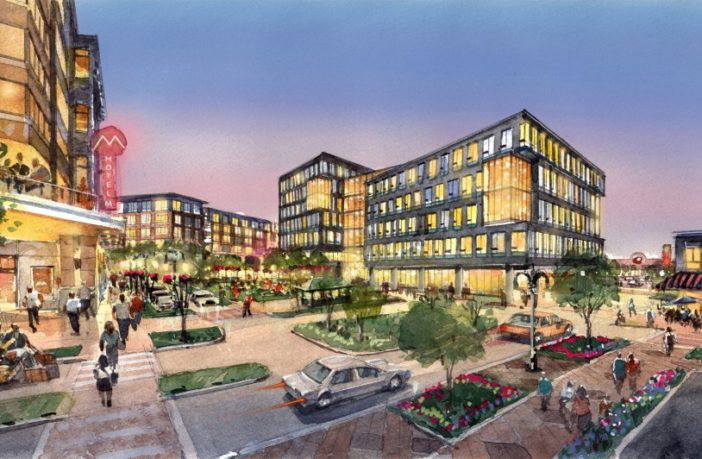By Megan Sayles,
AFRO Business Writer,
msayles@afro.com
Angela Alsobrooks became county executive of Prince George’s County, Md. in 2018 with an economic vision to grant Prince Georgians access to amenities that they had been missing for decades.
Her objective was to create jobs, broaden the tax base, mitigate food deserts, provide capital access to small and local businesses and bring entertainment spaces to the county.
Today, that vision is being realized through the Blue Line Corridor, the county’s anchor initiative for place-based economic development. The plan relies on transit-oriented development which generates jobs, housing and services through public transportation. In this case, it means four Blue Line Metrorail stations will open in the county.
“The Blue Line Corridor is an area where we envision a sports and entertainment district, as well as the attraction of amenities and dining opportunities along a corridor that is attached to transit. The Largo, Morgan Boulevard, Addison Road and Capitol Heights stations feed into communities that have been left behind,” said Alsobrooks. “Some of the things you’ll see coming out of the Blue Line Corridor [are]an amphitheater, a major youth sports and entertainment venue, a cultural center and a food hall.”
Prince George’s County was able to secure more than $400 million in bonds from the Maryland Stadium Authority for the transformation, as well as $700 million from the private sector.
The federal government also awarded the county $25 million for the Blue Line Corridor through a Rebuilding American Infrastructure with Sustainability and Equity (RAISE) grant from the U.S. Department of Transportation. These funds will specifically be used to create the Central Avenue Connector Trail, which will provide biker and pedestrian transportation to Metrorail stations.
“The Washington Metropolitan Area Transit Authority’s (WMATA) metro system connects communities inside the beltway in Virginia, D.C. and Maryland, but the stops are not the same. In the past 40 years, you’ll find that the fixed transportation corridors have driven growth and mixed-use development all across the region,” said Alsobrooks. “But unlike all the other stops elsewhere, our Blue Line Corridor stations look very similar to the way they looked over 40 years ago. Our sites have had very little investment.”
The county executive said access to transit is key to an area’s prosperity. It has the potential to propel social connectedness, enhance quality of life, reduce crime and foster higher education attainment.
Several mixed-use developments will be constructed around the Metrorail stations as they are renovated. The projects will provide residential, retail and community spaces for Prince Georgians.
Each are being managed by local, Black-led development companies, including Banneker Ventures, The Velocity Companies, The Community Builders and Harambe Development Group.
Once completed, Hampton Park will have a hotel, retail space and nearly 400 residential units.
(Courtesy Photo)
Brandon Bellamy, CEO of The Velocity Companies, will be leading the $250-million development of what was formerly known as Hampton Mall. The two-phase, mixed-use project, Hampton Park, broke ground in 2019 and is slated to provide a hotel, 100,000 square feet of retail space and nearly 400 residential units.
It’s also the new home of the Prince George’s County Health and Human Services Building.
“The developers on the Blue Line Corridor right now are all African-American-led companies, and I think that’s a big deal. You don’t get economic development without real estate development,” said Bellamy. “It’s unique in America to have an African-American county executive investing a billion dollars into a corridor for a [predominantly]African-American county—one of the most affluent in the country— and the major developments are all owned and primed by African-American firms.”
For Bellamy, the Blue Line Corridor is the key to ensuring Prince Georgians don’t have to travel outside of the county to obtain goods, services and entertainment.
“I think County Executive Alsobrooks realized that the people here were our greatest value, and she focused this entrepreneurial energy in the Blue Line Corridor,” said Bellamy. “Because of that her legacy is forever cemented. This level of investment around Metro stations with so much density and pedestrian traffic can generate tax dollars, which we can use to improve roads, schools, life and safety issues.”
Prince George’s County is preparing to launch an education campaign surrounding the Blue Line Corridor to engage residents in its vision. Alsobrooks said she wants to be proactive in providing the community with updates and receiving their feedback as developments occur.
The education campaign will include TV advertisements, radio spots and infographics.
Alsobrooks also said she is committed to ensuring that the development from the Blue Line Corridor does not push out current residents.
“One of the lessons we’ve learned just by observing how progress happens in other places similar to ours around the country is that you often build up and have all these amenities and then people who live here can no longer afford to live in their own community,” said Alsobrooks. “Over the last three years, we’ve been very intentional about supporting the preservation and creation of affordable housing units. We want to make sure that we are planning for affordable housing as we plan for this additional economic opportunity so everyone here can enjoy the newfound prosperity as the county experiences it.”
Megan Sayles is a Report for America Corps member.



